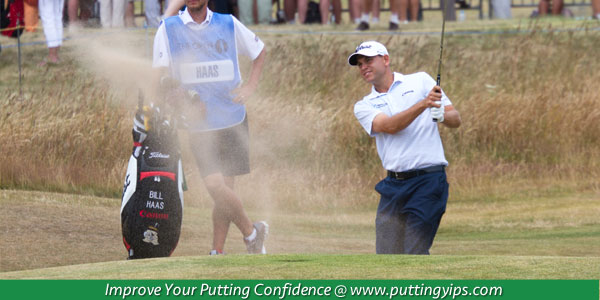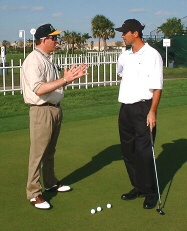
Why Does Your Stoke Change?
Does your putting stroke feel different on the course?
Maybe you consider your putting game as your primary strength, then all of the sudden you can’t make a short putt.
Most golfers will attempt to work it out by spending more time on the practice green.
Some may try to change grip, switch putters or change stroke…
After all the work or changes to your putting, the on-course putting woes continue.
Why?
If you putt well on the practice green, but not on the course, improving your stroke is often not the answer (but the more obvious solution for golfers).
The key to unlock your performance on the course is to improve your mental game and address how your mind if affecting your game…
When all the practice is complete, the most important part of your game is your mental approach to golf.
Top golfers make the decision to improve their mental game.
For example, Rory McIlroy struggled with his short game at times during the 2015 season. McIlroy’s short-game difficulties were obvious at the 2015 Frys.com Open where he finished tied for 26th place.
McIlroy commented that his troubles with his short game were more mental than physical. After the 3rd Round, McIlroy, talked about how a few missed putts can dramatically affect his mental game.
MCILROY: “I don’t think it’s a technical issue at all because I putt the ball really well on the putting green. Then I got out there and I hole a couple and maybe I’ll miss one or two and it gets into my head. It’s more a mental thing and trying to trust myself a little bit more.”
McIlroy spoke about how working with a Sport Psychologist has helped him overcome similar issues in the past.
MCILROY: “I’ve spoken to some people before: Spoken to caddie Dave [Renwick] about the mental side of putting; Worked with a [Sport Psychologist] back in 2010. There are different ways [to overcome it].”
Improving your mental game can help you identify why your putting changes on the course, such as:
- Fear of missing
- Fear of not playing to potential
- Worry about disappointing a partner
- Trying too hard
- Being too cautious and not wanting to 3-putt.
The first step is to find out what’s getting in the way of a smooth or relaxed stroke on the course.
And keep in mind: strokes don’t break down under pressure, golfers’ minds do.
Tips for Improving your Mind Game
Know how your putting changes on the course. For example, how does your stroke change, such as it feels tight or jerky?
How does your thinking change on the course? For example, do you stop believing you can make putts after you miss one early in the round?
You may have the putting yips. However, not all putting woes comes from having the yips. Check out Breaking The Yips Cycle to see if you have the yips!
Related Golf Psychology Articles:
- Does Your Putting Change on the Course?
- Did You Change Your Putter to Beat The Yips?
- How to Stop the Yips Cycle Before it Starts
Improve Your Mental Game From Anywhere In The World

Learn how to think like a great putter and develop mental toughness with one-on-one golf psychology coaching for putting yips by mental game of golf experts at Peak Performance Sports!
You can get expert yips mental coaching with us from anywhere. Meet with us via Skype, phone, FaceTime, or GoTo Meeting. With today’s video technology, we are able to connect with athletes and coaches all over the globe.
We help golfers win at all levels including AJGA junior golfers, collegiate golfers, mini-tour golfers, Canadian Tour, PGA Tour, and LPGA Tour golfers. Find a sports psychologist near me.
Call Us Today to Schedule Your Free 15-Minute Session.
Find Out If You Can Benefit From One-on-One Mental Coaching!
888-742-7225 | 407-909-1700
